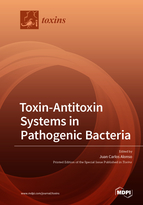Toxin-Antitoxin Systems in Pathogenic Bacteria
A special issue of Toxins (ISSN 2072-6651). This special issue belongs to the section "Bacterial Toxins".
Deadline for manuscript submissions: closed (31 July 2020) | Viewed by 35152
Special Issue Editor
Interests: genome stability; recombination-dependent replication; chromosome segregation; toxin-antitoxins
Special Issues, Collections and Topics in MDPI journals
Special Issue Information
Dear Colleagues,
Bacterial toxin–antitoxin (TA) systems, which are ubiquitously present in bacterial genomes, are not essential for normal cell proliferation. The TAs regulate fundamental cellular processes, facilitate survival under stress conditions, have essential roles in persistence and virulence, and represent potential therapeutic targets. These genetic TA loci are also shown to be involved in the maintenance of successful multidrug-resistant mobile genetic elements. TA systems encode a labile antitoxin and its stable toxin; degradation of the antitoxin renders a free toxin, which is bacteriostatic by nature. A free toxin generates a reversible state with low metabolic activity (quiescence) by affecting important functions of bacterial cells such as transcription, translation, DNA replication, replication and cell–wall synthesis, biofilm formation, phage predation, the regulation of nucleotide pool, etc., whereas antitoxins are toxin inhibitors. Under stress conditions, the TA systems might form networks. Understanding the basis of the unique response of TAs to stress, the prime causes for the emergence of drug-resistant strains, and their contribution to therapy failure and development of chronic and recurrent infections are necessary to grasp how TAs contribute to the mechanisms of phenotypic heterogeneity and pathogenesis that will enable the development of rational development of new treatment for infections caused by pathogens.
Prof. Dr. Juan Carlos Alonso
Guest Editor
Manuscript Submission Information
Manuscripts should be submitted online at www.mdpi.com by registering and logging in to this website. Once you are registered, click here to go to the submission form. Manuscripts can be submitted until the deadline. All submissions that pass pre-check are peer-reviewed. Accepted papers will be published continuously in the journal (as soon as accepted) and will be listed together on the special issue website. Research articles, review articles as well as short communications are invited. For planned papers, a title and short abstract (about 100 words) can be sent to the Editorial Office for announcement on this website.
Submitted manuscripts should not have been published previously, nor be under consideration for publication elsewhere (except conference proceedings papers). All manuscripts are thoroughly refereed through a double-blind peer-review process. A guide for authors and other relevant information for submission of manuscripts is available on the Instructions for Authors page. Toxins is an international peer-reviewed open access monthly journal published by MDPI.
Please visit the Instructions for Authors page before submitting a manuscript. The Article Processing Charge (APC) for publication in this open access journal is 2700 CHF (Swiss Francs). Submitted papers should be well formatted and use good English. Authors may use MDPI's English editing service prior to publication or during author revisions.
Keywords
- stable toxin
- labile antitoxin
- bacteriostatic TA mechanism
- bacterial persistence
- multidrug-resistant hospital infections
- antibacterial strategy







